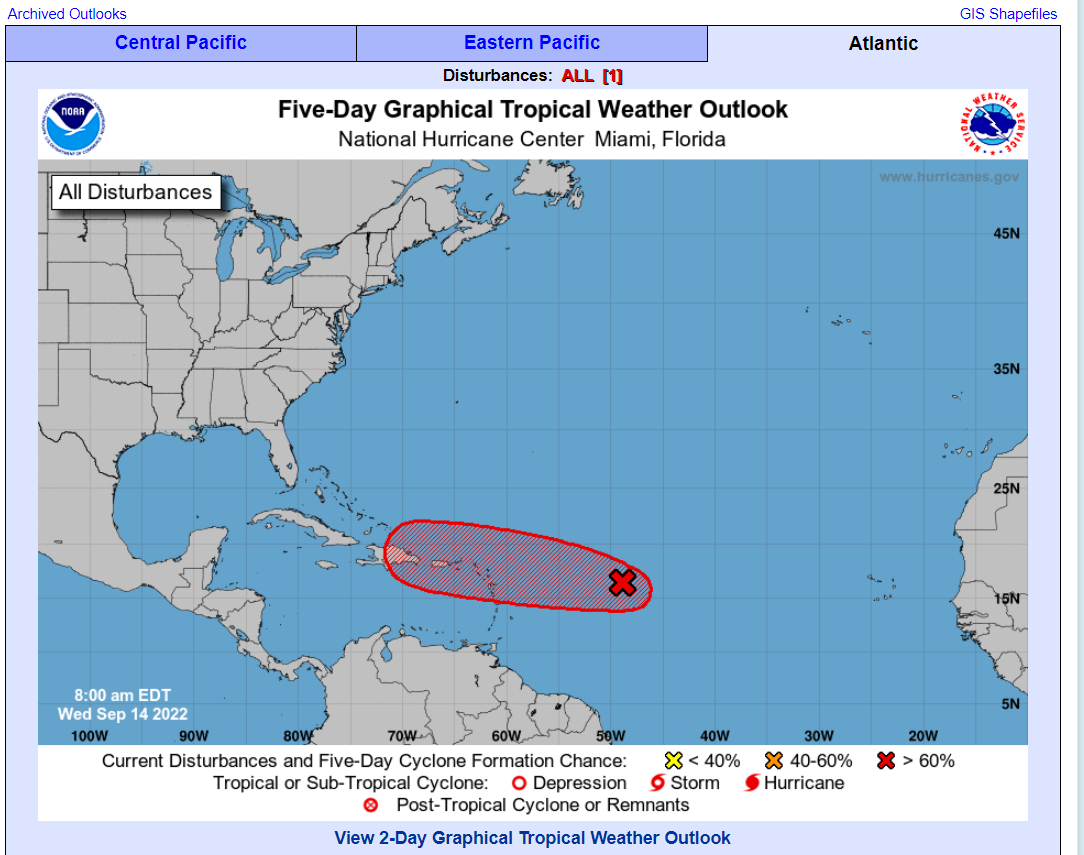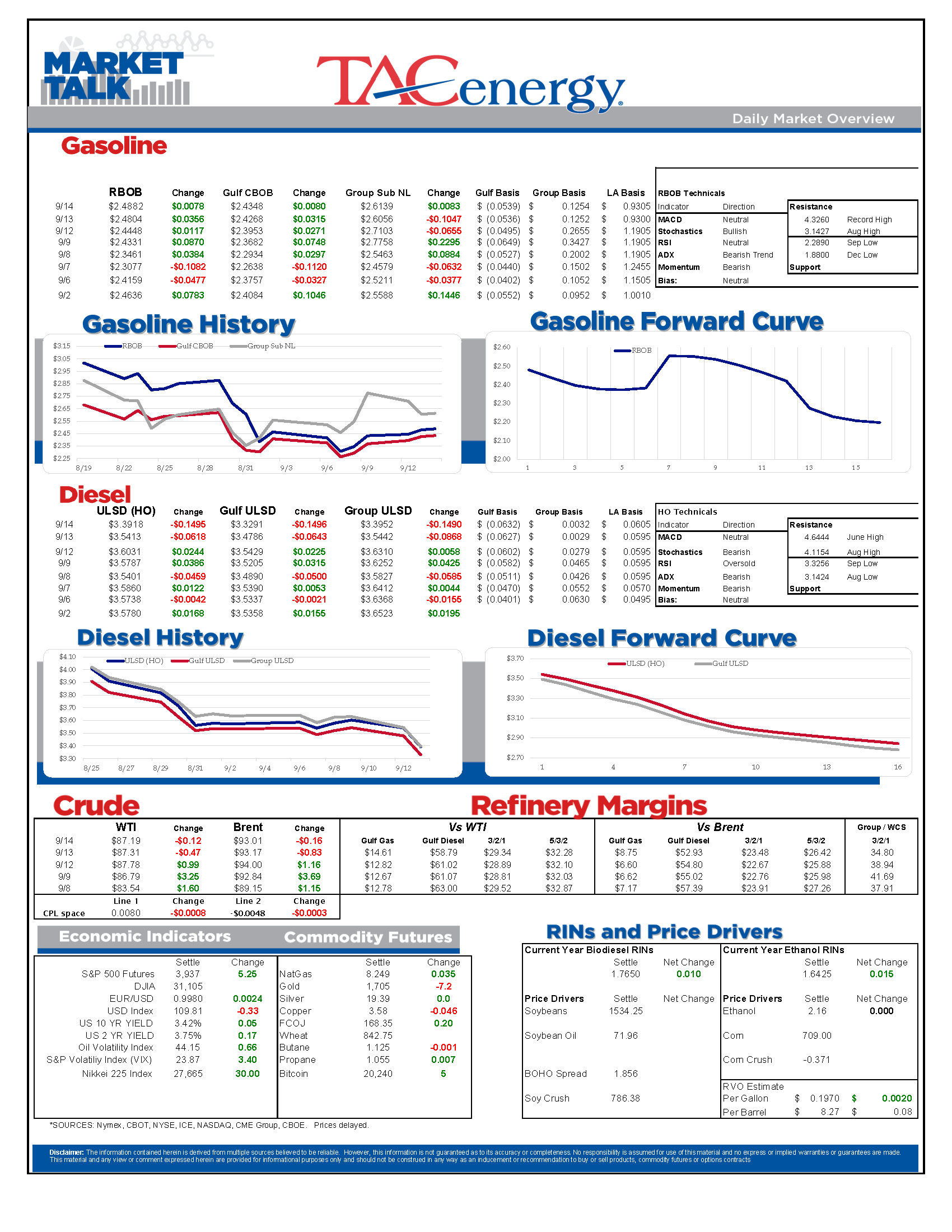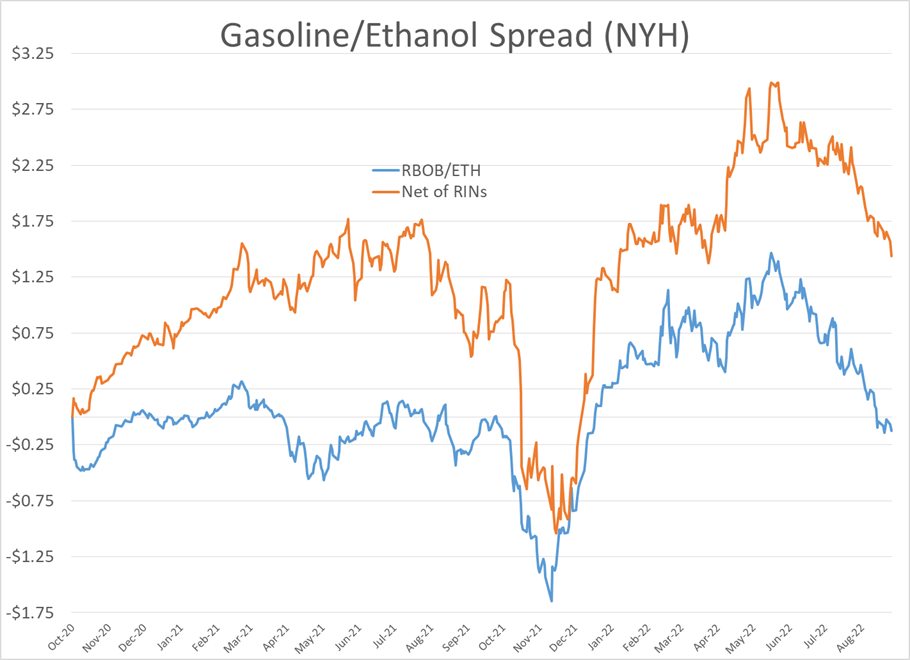Diesel Prices Fell Out Of Bed Wednesday Dropping More Than 20 Cents At One Point To A 5 Week Low

Diesel prices fell out of bed Wednesday dropping more than 20 cents at one point to a 5 week low, even as gasoline and crude prices hold around break even for the day. There’s not a clear reason for the big drop in diesel while WTI and RBOB are neutral, but it appears that recession/demand fears may outweigh supply fears as fuel inventories in the US and abroad show signs of recovery.
US stock markets had their worst day in more than 2 years Tuesday following a discouraging inflation report that doomed hopes of the FED easing up on their plans to raise interest rates and tighten the money supply anytime soon. Diesel prices have had a negative correlation to the S&P 500 in recent months, so it doesn’t seem there’s an immediate connection between the selling in the asset classes, but there’s no denying that a recession would take a heavy toll on distillate demand.
A report by a major US investment bank suggested that European natural gas prices would be cut in half this winter as widespread efforts to solve the Russian energy shortages are proving successful. If that prediction plays out, it suggests a lower need to switch to diesel fuel as a supplemental option for electricity generation.
Ethanol prices have surged this week, alongside corn prices following a bullish crop report from the USDA. Another factor to watch closely in ethanol markets is a looming railroad strike that could hamper the primary transportation method for numerous commodities, including grain alcohol that goes into your fuel tank. The gasoline price vs Ethanol, both gross and net of RIN values, has fallen to its lowest level of the year as gasoline prices have come under pressure while ethanol rebounds.
The potential railroad strike would be a double-edged sword for diesel prices, both reducing the 2nd largest demand source for diesel, while also putting a key supplemental supply source at risk for markets that can’t be fully stocked by pipeline or waterborne options. There is a possibility that some of today’s action in ULSD futures could be related to major railroads unwinding fuel hedges if they now anticipate their actual consumption to be below expected levels, but there’s no way to prove whether or not that’s happening.
The API reported a large build in US commercial crude oil stocks of 6 million barrels last week, but since the SPR was drawn down by more than 8 million barrels, the total oil inventories in the US actually fell again during the week. Distillates increased by 1.7 million barrels while gasoline stocks declined by 3.2 million barrels, which looks like it’s contributing to the big price disparity between products this morning. The EIA’s weekly report is due out at its normal time this morning.
The NHC gives a 70% chance that we’ll see another named storm in the Atlantic this weekend, which would be named Fiona. Most early models show this system turning north and east and avoiding a US Landfall, but a few still leave the door open for this storm to get into the Gulf of Mexico and threaten oil production and refineries, so it can’t be dismissed completely yet.
Click here to download a PDF of today's TACenergy Market Talk.
Latest Posts
The Sell-Off Continues In Energy Markets, RBOB Gasoline Futures Are Now Down Nearly 13 Cents In The Past Two Days
Week 15 - US DOE Inventory Recap
Prices To Lease Space On Colonial’s Main Gasoline Line Continue To Rally This Week
Equity Markets Have Been Pulling Back Sharply In Recent Days As Inflation And Trade Concerns Inject A Sense Of Reality Into Stocks
Social Media
News & Views
View All
The Sell-Off Continues In Energy Markets, RBOB Gasoline Futures Are Now Down Nearly 13 Cents In The Past Two Days
The sell-off continues in energy markets. RBOB gasoline futures are now down nearly 13 cents in the past two days, and have fallen 16 cents from a week ago, leading to questions about whether or not we’ve seen the seasonal peak in gasoline prices. ULSD futures are also coming under heavy selling pressure, dropping 15 cents so far this week and are trading at their lowest level since January 3rd.
The drop on the weekly chart certainly takes away the upside momentum for gasoline that still favored a run at the $3 mark just a few days ago, but the longer term up-trend that helped propel a 90-cent increase since mid-December is still intact as long as prices stay above the $2.60 mark for the next week. If diesel prices break below $2.50 there’s a strong possibility that we see another 30 cent price drop in the next couple of weeks.
An unwind of long positions after Iran’s attack on Israel was swatted out of the sky without further escalation (so far anyway) and reports that Russia is resuming refinery runs, both seeming to be contributing factors to the sharp pullback in prices.
Along with the uncertainty about where the next attacks may or may not occur, and if they will have any meaningful impact on supply, come no shortage of rumors about potential SPR releases or how OPEC might respond to the crisis. The only thing that’s certain at this point, is that there’s much more spare capacity for both oil production and refining now than there was 2 years ago, which seems to be helping keep a lid on prices despite so much tension.
In addition, for those that remember the chaos in oil markets 50 years ago sparked by similar events in and around Israel, read this note from the NY Times on why things are different this time around.
The DOE’s weekly status report was largely ignored in the midst of the big sell-off Wednesday, with few noteworthy items in the report.
Diesel demand did see a strong recovery from last week’s throwaway figure that proves the vulnerability of the weekly estimates, particularly the week after a holiday, but that did nothing to slow the sell-off in ULSD futures.
Perhaps the biggest next of the week was that the agency made its seasonal changes to nameplate refining capacity as facilities emerged from their spring maintenance.
PADD 2 saw an increase of 36mb/day, and PADD 3 increased by 72mb/day, both of which set new records for regional capacity. PADD 5 meanwhile continued its slow-motion decline, losing another 30mb/day of capacity as California’s war of attrition against the industry continues. It’s worth noting that given the glacial pace of EIA reporting on the topic, we’re unlikely to see the impact of Rodeo’s conversion in the official numbers until next year.
Speaking of which, if you believe the PADD 5 diesel chart below that suggests the region is running out of the fuel, when in fact there’s an excess in most local markets, you haven’t been paying attention. Gasoline inventories on the West Coast however do appear consistent with reality as less refining output and a lack of resupply options both continue to create headaches for suppliers.

Week 15 - US DOE Inventory Recap

Prices To Lease Space On Colonial’s Main Gasoline Line Continue To Rally This Week
Energy markets are sliding lower again to start Wednesday’s trading as demand concerns and weaker stock markets around the world seem to be outweighing any supply concerns for the time being.
Rumors continue to swirl about an “imminent” response by Israel to Iran’s attacks, but so far, no news seems to be taken as good news in the hopes that further escalation can be avoided, even as tensions near the Red Sea and Strait of Hormuz continue to simmer.
Prices to lease space on Colonial’s main gasoline line continue to rally this week, trading north of 11 cents/gallon as Gulf Coast producers still struggle to find outlets for their production, despite a healthy export market. Gulf Coast CBOB is trading at discounts of around 34 cents to futures, while Gulf Coast RBOB is trading around a 16-cent discount, which gives shippers room to pay up for the linespace and still deliver into the East Coast markets at a profit.
Back to reality, or just the start of more volatility? California CARBOB basis values have dropped back to “only” 40 cent premiums to RBOB futures this week, as multiple flaring events at California refineries don’t appear to have impacted supply. The state has been an island for fuel supplies for many years as its boutique grades prevent imports from neighboring states, and now add the conversion of the P66 Rodeo refinery to renewable diesel production and the pending changes to try and cap refinery profits, and it’s easier to understand why these markets are increasingly vulnerable to supply shocks and price spikes on gasoline.
RIN prices continue to fall this week, touching 44 cents/RIN for D4 and D6 values Tuesday, their lowest level in 6 weeks and just about a nickel above a 4-year low. While the sharp drop in RIN and LCFS values has caused several biodiesel and Renewable Diesel producers to either shut down or limit production, the growth in RIN generation continues thanks to projects like the Rodeo refinery conversion, making the supply in RINs still outpace the demand set by the Renewable Fuel Standard by a wide margin.
The API reported draws in refined products, 2.5 million barrels for gasoline and 427,000 barrels for distillates, while crude oil stocks had an estimated build of more than 4 million barrels. The DOE’s weekly report is due out at its normal time this morning.
Click here to download a PDF of today's TACenergy Market Talk.






